
Dawn at Sea
Stevens Custom 42 cruising from Maine to the Windwards and back
10 May 2017 | Havana, Cuba
22 April 2017 | Havana, Cuba
22 April 2017 | Havana, Vieja, Cuba
17 April 2017 | San Francisco de Paula, Cuba
17 April 2017 | Jaiminitas, Cuba
03 April 2017 | Pompano Beach, FL
19 September 2016 | ashore in Maine
19 August 2015 | Rockland, Maine
30 May 2015 | Rockland, Maine
28 May 2015 | Rockland, Maine
28 May 2015 | Irvington, VA
16 May 2015
13 May 2015 | Irvington, VA
04 May 2015 | Beaufort, NC
01 May 2015 | Charleston, SC
27 April 2015 | Brunswick,
20 April 2015 | St Augustine
20 April 2015 | St Augustine, FL
15 April 2015 | Melbourne, FL
08 April 2015 | New Providence, Bahamas
The People of Cuba Today
10 May 2017 | Havana, Cuba
Elaine Dresser
I hear people say that they want to go to Cuba before major changes occur there. I say, "Go now and hope changes comes quickly."
I came away wondering why people live the way they do. Cuban families register with local supply stores and receive a libreta, a ration book which allows them very basic food supplies each month. More than half of the rationed food is rice, the main staple of their menu. Other products like eggs, meat and fish, when available, are limited with only enough to last a few days.
Most Cubans receive 500 pesos, approximately twenty-one US dollars, each month as a salary from the government. Street markets sell locally grown vegetables, fruits, homemade butter and cheeses, but 500 pesos spends fast. A kilo of powdered milk, something most Cubans go without, costs approximately one-third of a monthly salary. I think of "The Black Market" as a source of contraband. In Cuba it is also a source of food, since markets and ration shops run out of basics and don't carry many items that people need.
Personal hygiene items, including toothpaste, tooth brushes, shampoo, and soap are inaccessible to local people because they are unable to afford such items. Paper, pencils, and even toilet paper are scarce. Items that we consider necessities, they consider luxuries. Cubans can use everything.
Before going to Cuba, I read that Cubans accept and appreciate gifts from tourists. Children need pencils and everyone can use whatever you offer. We distributed bags with personal hygiene items to people we met each day and handed candies to people up and down the streets as we walked along the city sidewalks, bringing smiles and "gracias" from all. A few people were skeptical at first when handed a bag, but the facial expressions changed quickly to delight and gratitude when they looked inside.
If my Spanish were better, I would have enjoyed conversations with people I met. There was little exchange of words besides "regalo" and "gracias" but there was real communication and emotion expressed.
Each exchange is a touching story. Smiles, thanks, hugs and even a kiss one time, were my gifts in return from very friendly, kind, and caring people. Still, there was something bittersweet about the experience. Personal hygiene items should not be luxuries.
Let's hope that change will come and it will come soon for the people of Cuba.
I came away wondering why people live the way they do. Cuban families register with local supply stores and receive a libreta, a ration book which allows them very basic food supplies each month. More than half of the rationed food is rice, the main staple of their menu. Other products like eggs, meat and fish, when available, are limited with only enough to last a few days.
Most Cubans receive 500 pesos, approximately twenty-one US dollars, each month as a salary from the government. Street markets sell locally grown vegetables, fruits, homemade butter and cheeses, but 500 pesos spends fast. A kilo of powdered milk, something most Cubans go without, costs approximately one-third of a monthly salary. I think of "The Black Market" as a source of contraband. In Cuba it is also a source of food, since markets and ration shops run out of basics and don't carry many items that people need.
Personal hygiene items, including toothpaste, tooth brushes, shampoo, and soap are inaccessible to local people because they are unable to afford such items. Paper, pencils, and even toilet paper are scarce. Items that we consider necessities, they consider luxuries. Cubans can use everything.
Before going to Cuba, I read that Cubans accept and appreciate gifts from tourists. Children need pencils and everyone can use whatever you offer. We distributed bags with personal hygiene items to people we met each day and handed candies to people up and down the streets as we walked along the city sidewalks, bringing smiles and "gracias" from all. A few people were skeptical at first when handed a bag, but the facial expressions changed quickly to delight and gratitude when they looked inside.
If my Spanish were better, I would have enjoyed conversations with people I met. There was little exchange of words besides "regalo" and "gracias" but there was real communication and emotion expressed.
Each exchange is a touching story. Smiles, thanks, hugs and even a kiss one time, were my gifts in return from very friendly, kind, and caring people. Still, there was something bittersweet about the experience. Personal hygiene items should not be luxuries.
Let's hope that change will come and it will come soon for the people of Cuba.
"Frienemies"
22 April 2017 | Havana, Cuba
Dutch Dresser
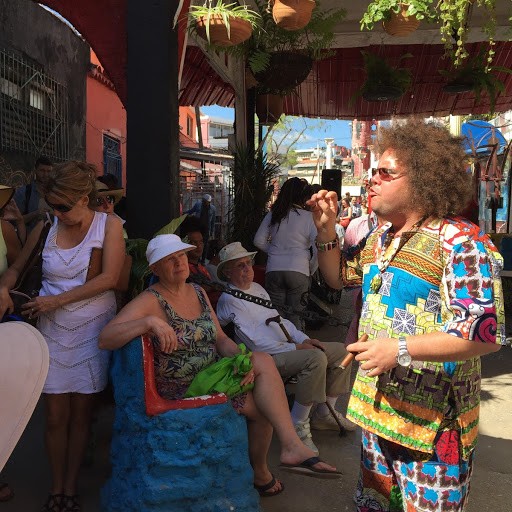
On Sunday, we headed to Havana Vieja (Habana bieja) to find an alley called Callejon de Hamel’s, where Afrocubanos have made a community statement about their culture by creating art on the walls and in the small, dark storefronts. A few bars and a paladar are among the galleries.
On Sundays those who are part of this project come together from noon to 1430 to play music and dance for all comers. The tiny alley, one block long was filled with all manner of people, Cubanos, Afrocubanos, white tourists, Rastafarians, and on and on. During the introduction the project director during his announcement en español, welcomes friends from all nations and their “frienemies from the United States of America.”
After noon, the dance troupe arrived and the rumba music began. It had a strong, persistent African beat and the dancers were energetic in their renditions of rumba and African dance. Elaine was fortunate to have a ringside seat; I was in the sweaty crowd in which there was no “personal space.” After an hour, I had to look for relief on the street away from the din and claustrophobic crush.
Propaganda critical of the United States was easy to find. Taller Experimental de Grafica, a graphic arts museo in Havana Vieja, had beautiful, aggrandizing, depictions of Revolutionary leaders with plenty of anti-American rhetoric describing them. Reminiscences of US behaviors in Viet Nam and Iraq were plentiful, critical, and ghastly. Despite its location in the heart of the tourist section of Old Havana none of the rhetoric was translated from Spanish into any other language while many other postings were translated into English.
Elaine and I visited Hotel Nacional de Cuba; it’s a beautiful international hotel overlooking the sea from atop a hillside. During the Cuban missile crisis, the government built a network of tunnels and bunkers under the front lawn of this magnificent hotel. Those tunnels and bunkers are now a significant tourist attraction with lots of signage describing the Cuban Missle Crisis and the Russian/Cuban victory it represented over the United States.
I was in both the US Naval Reserve and high school when the crisis broke out and wasn’t called to active duty when my ship was, probably because of my school status. I must admit that I’ve learned more about the crisis since I’ve returned to the US and had open access to information than I’d ever known before. That the event still has currency in Cuban propaganda supports the view that this is a country still living in the 1950’s and ‘60’s.
Despite the official governmental stance on American relations, we all felt welcome among the people we met and encountered.
On Sundays those who are part of this project come together from noon to 1430 to play music and dance for all comers. The tiny alley, one block long was filled with all manner of people, Cubanos, Afrocubanos, white tourists, Rastafarians, and on and on. During the introduction the project director during his announcement en español, welcomes friends from all nations and their “frienemies from the United States of America.”
After noon, the dance troupe arrived and the rumba music began. It had a strong, persistent African beat and the dancers were energetic in their renditions of rumba and African dance. Elaine was fortunate to have a ringside seat; I was in the sweaty crowd in which there was no “personal space.” After an hour, I had to look for relief on the street away from the din and claustrophobic crush.
Propaganda critical of the United States was easy to find. Taller Experimental de Grafica, a graphic arts museo in Havana Vieja, had beautiful, aggrandizing, depictions of Revolutionary leaders with plenty of anti-American rhetoric describing them. Reminiscences of US behaviors in Viet Nam and Iraq were plentiful, critical, and ghastly. Despite its location in the heart of the tourist section of Old Havana none of the rhetoric was translated from Spanish into any other language while many other postings were translated into English.
Elaine and I visited Hotel Nacional de Cuba; it’s a beautiful international hotel overlooking the sea from atop a hillside. During the Cuban missile crisis, the government built a network of tunnels and bunkers under the front lawn of this magnificent hotel. Those tunnels and bunkers are now a significant tourist attraction with lots of signage describing the Cuban Missle Crisis and the Russian/Cuban victory it represented over the United States.
I was in both the US Naval Reserve and high school when the crisis broke out and wasn’t called to active duty when my ship was, probably because of my school status. I must admit that I’ve learned more about the crisis since I’ve returned to the US and had open access to information than I’d ever known before. That the event still has currency in Cuban propaganda supports the view that this is a country still living in the 1950’s and ‘60’s.
Despite the official governmental stance on American relations, we all felt welcome among the people we met and encountered.
Driving Along the Malecon
22 April 2017 | Havana, Vieja, Cuba
Dutch Dresser
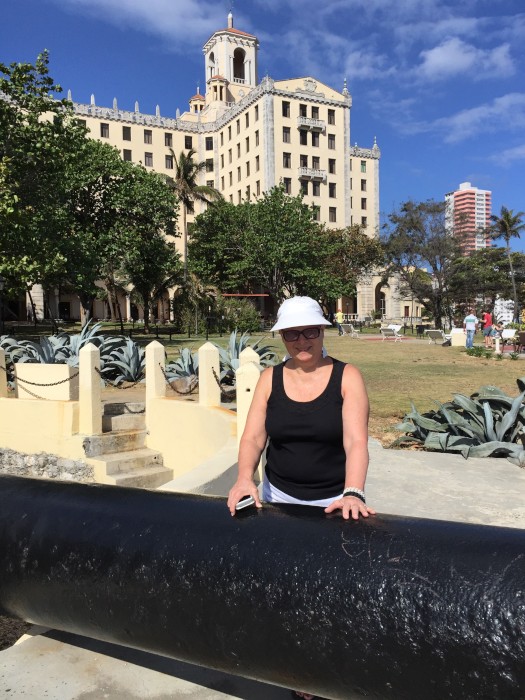
The pace is tiring folks out, so the boat "slept in" until 0800 on day three. We hustled to meet the cab, a '56 Chevy station wagon. All were anxious for coffee, so we stopped at a nearby panaderia, chose the pastries we would order when we reached the head of the queue, and then learned that the coffeemaker was broken and would be repaired mañana. (We had a similar response when we ordered a piña colada at a bar in the Nacional Hotel that had lots of mojito glasses all set up. "I'm afraid the blender is broken, just now, sir." One must wonder.) Off we went to a panaderia in a business complex in Havana.
Our Spanish and the waitress's English worked to get the orders placed. I headed to the baño, paid the disinterested attendant, and found the usual...no seat, no paper! Fortunately, neither was an issue.
Breakfast was served, and I was proud to be able to ask en espánol for sal y pimienta...alas, salt was available, but no pepper, a theme to be played out in all government restaurants.
A whirlwind tour through Havana Vieja introduced us to the lay of the land. Lots of named squares, statuary of revolutionary heroes, Fords, Chevys, Studebakers, and assorted other American cars from the'40's and '50's, Russian cars and trucks including Ladas and the tiniest little four-seater I've ever seen, the Polski Fiat 126p made in Poland. The cars were accompanied by droves of insistent taxi drivers anxious to take you somewhere.
Havana Vieja has been largely beautified. It is tourist friendly and filled with chances to drink rum and buy souvenirs. Paladars and government restaurants are plentiful. Men on the street whisper that they have good prices on Cohibas; "no fumar" sends them on their ways.
On the ride back from Havana, Mikail, our taxi driver pulled over to the side of the Malecon, and said "you drive." I was surprised and delighted, so I got into the driver's seat of a '56 Chevy with a Rumanian diesel and a Toyota steering wheel loosely attached to the steering systems of the old Chevy. Away we went without incident, as I was reminded of my days behind the wheel of my parents' '57 Bel Air. Everyone took pictures of "Hemingway" driving the old Chevy.
We headed out late for dinner at La Foresta, a very well-appointed paladar, 3 or 4 kilometers from the marina. Paladars are privately-owned restaurants. These private restaurants have been involved in governmental whiplash for some time. They provide the best opportunity for interesting food. These restaurants have well-seasoned, well-presented food while the more common government-owned facilities have more ordinary fare with little seasoning. Pepper for seasoning is uncommon as it is very expensive here. Two peppercorns cost about $1CUC (~$1.10US) here.
Four of us found the paella an attractive option that yielded plenty of shrimp, langusta, clams and fish in the well-seasoned bed of rice. We enjoyed the meal in an open courtyard as a saxophonist played beautifully...a good ending to another busy day.
Our Spanish and the waitress's English worked to get the orders placed. I headed to the baño, paid the disinterested attendant, and found the usual...no seat, no paper! Fortunately, neither was an issue.
Breakfast was served, and I was proud to be able to ask en espánol for sal y pimienta...alas, salt was available, but no pepper, a theme to be played out in all government restaurants.
A whirlwind tour through Havana Vieja introduced us to the lay of the land. Lots of named squares, statuary of revolutionary heroes, Fords, Chevys, Studebakers, and assorted other American cars from the'40's and '50's, Russian cars and trucks including Ladas and the tiniest little four-seater I've ever seen, the Polski Fiat 126p made in Poland. The cars were accompanied by droves of insistent taxi drivers anxious to take you somewhere.
Havana Vieja has been largely beautified. It is tourist friendly and filled with chances to drink rum and buy souvenirs. Paladars and government restaurants are plentiful. Men on the street whisper that they have good prices on Cohibas; "no fumar" sends them on their ways.
On the ride back from Havana, Mikail, our taxi driver pulled over to the side of the Malecon, and said "you drive." I was surprised and delighted, so I got into the driver's seat of a '56 Chevy with a Rumanian diesel and a Toyota steering wheel loosely attached to the steering systems of the old Chevy. Away we went without incident, as I was reminded of my days behind the wheel of my parents' '57 Bel Air. Everyone took pictures of "Hemingway" driving the old Chevy.
We headed out late for dinner at La Foresta, a very well-appointed paladar, 3 or 4 kilometers from the marina. Paladars are privately-owned restaurants. These private restaurants have been involved in governmental whiplash for some time. They provide the best opportunity for interesting food. These restaurants have well-seasoned, well-presented food while the more common government-owned facilities have more ordinary fare with little seasoning. Pepper for seasoning is uncommon as it is very expensive here. Two peppercorns cost about $1CUC (~$1.10US) here.
Four of us found the paella an attractive option that yielded plenty of shrimp, langusta, clams and fish in the well-seasoned bed of rice. We enjoyed the meal in an open courtyard as a saxophonist played beautifully...a good ending to another busy day.
Papa Hemingway for a Day
17 April 2017 | San Francisco de Paula, Cuba
Dutch Dresser
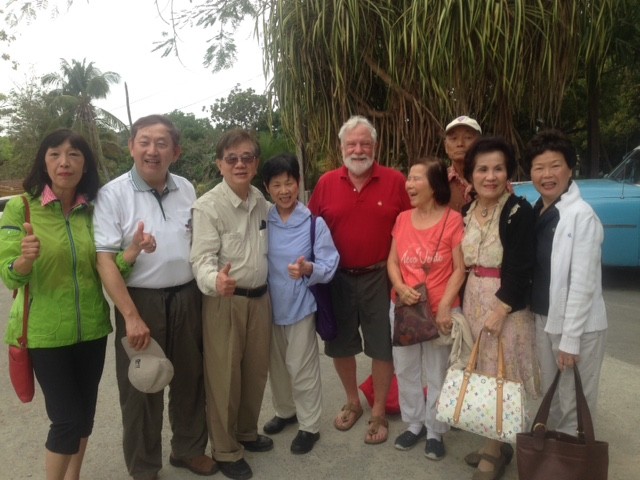
0800 we mustered with Adonis, the well-deserved name of our taxi driver organizer, for a trip to San Francisco de Paula, Cuba, to visit La Finca Vigia, the home of Ernest Hemingway. Central to the complex is Hemingway's house, which is open at the doorway but cordoned so you can't enter. You can see much of the house through the doors and windows, and you'd love to spend time in the comfortable setting with the stuffed trophies on the wall and the single remaining Picasso, the balance of the large art collection having been removed by Hemingway's wife after his death.
Atop a tower next to the house one has a remarkable view of the countryside from Hemingway's studio, where his typewriter sits on a table and paintings adorn the walls.
Pilar, Hemingway's boat, was on-site and surrounded by staging to be viewed from every angle. Hemingway commissioned the boat with his proceeds from some short stories and paid $7,500 for the sturdy powerboat.
After we toured, Elaine seated me in one of the wrought iron chairs under a banyan tree to take a photo, noting to a nearby Korean man that I look a bit like Hemingway. The man sprung to his feet to get the same picture. As we walked away, he caught up with us and wanted a picture with me; we obliged. He said something about Facebook and headed off gleefully. As we stood in the parking lot, looking at options, we were approached by the man and his extended family, about eight in all, wanting a group picture with "Hemingway" at the center. Soon I had my arms around two aged Korean ladies with family members of all ages smiling as Koreans and tourists and Elaine took pictures of the funny assemblage.
The tour went on to the small coastal village of Cojimar where La Terrazza, one of Hemingway's favorite haunts, has been restored by the government and serves mojitos and daiquiris to lots of tourists each day. It was a beautiful spot where, once again, I was recognized as "Hemingway" and called out by a musician in the group playing music to drink by.
As we walked the streets Elaine negotiated a deal on a Cuban license plate to hang in the tavern with several other plates already there.
I posed with a bust of Hemingway in the village center before boarding the taxis to head back to Marina Hemingway.
Atop a tower next to the house one has a remarkable view of the countryside from Hemingway's studio, where his typewriter sits on a table and paintings adorn the walls.
Pilar, Hemingway's boat, was on-site and surrounded by staging to be viewed from every angle. Hemingway commissioned the boat with his proceeds from some short stories and paid $7,500 for the sturdy powerboat.
After we toured, Elaine seated me in one of the wrought iron chairs under a banyan tree to take a photo, noting to a nearby Korean man that I look a bit like Hemingway. The man sprung to his feet to get the same picture. As we walked away, he caught up with us and wanted a picture with me; we obliged. He said something about Facebook and headed off gleefully. As we stood in the parking lot, looking at options, we were approached by the man and his extended family, about eight in all, wanting a group picture with "Hemingway" at the center. Soon I had my arms around two aged Korean ladies with family members of all ages smiling as Koreans and tourists and Elaine took pictures of the funny assemblage.
The tour went on to the small coastal village of Cojimar where La Terrazza, one of Hemingway's favorite haunts, has been restored by the government and serves mojitos and daiquiris to lots of tourists each day. It was a beautiful spot where, once again, I was recognized as "Hemingway" and called out by a musician in the group playing music to drink by.
As we walked the streets Elaine negotiated a deal on a Cuban license plate to hang in the tavern with several other plates already there.
I posed with a bust of Hemingway in the village center before boarding the taxis to head back to Marina Hemingway.
Airport to Aeropuerto
17 April 2017 | Jaiminitas, Cuba
Dutch Dresser
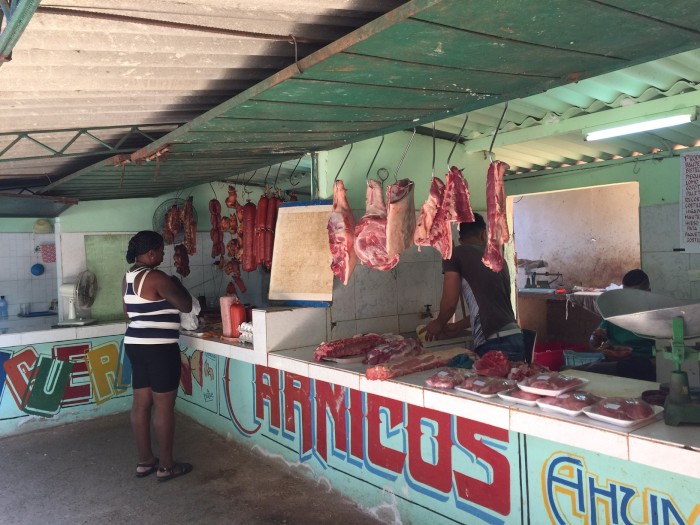
Elaine and I helped organize the Salty Dawg Rally to Cuba and enjoyed participating in the Cuban visit because of a generous offer by Hank and Seale George to join them aboard their Catana 471, Flash. The blogs that follow are some of our observations of the ten day visit.
An early night to bed in the Ft Lauderdale condo didn't result in a good night's sleep. As usual, both Elaine and I woke up hourly to check the clock. We were faced with returning a rental car a half hour away at 0500 to catch the first shuttle to the airport. The typical electronic check-in had failed saying that our flight was "restricted," so we would have to see an official at the airport. Of course that was because we were headed to Cuba and we'd need to show visas and, for the US bureaucracy, indicate the purpose of our visit to the island nation.
0430 saw us in the rental car headed to Ft Lauderdale, no coffee, no breakfast and blurry eyes. At the desk, we comfortably checked box 5, Education, because we had a well-defined program and work schedule all worked out with the Salty Dawg Sailing Association and the Rally to Cuba.
The flight was short and on time Havana International Airport was modern, clean and accustomed to dealing with people like us. Immigration took our picture and the customs officials trusted our "nothing to declare" statement. We were in Cuba as easily as we enter Canada, our immediate neighbor to the north.
A cab driver approached us immediately with a friendly demeanor, an offer of the espresso he had just ordered, and an explanation of money changing and costs to get to our destination...30 CUC (Cuban currency for visitors, or $35US. We changed some money ($1US = .87 CUC, although you can do better some places), jumped in the cab and headed for the marina. Twenty minutes later, at 1000, after talking to various guards, we were at Canal 4 at Marina Hemingway being greeted by Hank and Seale on Flash, their Catana 471.
After unpacking a few things, having a quick lunch we were deep into helping organize membership enrollments for Hemingway International Yacht Club before an afternoon meeting with Commodoro Escrich, my long-time e-mail buddy. The Commodore's vision, not just for Hemingway International Yacht Club, but also for the role of Cuba, and, specifically, Havana in the development of yachting in the eastern Caribbean is grand. The Commodore is an entrepreneurial visionary to be certain, a challenging role in a government-controlled society.
In the evening we were on a patio behind the Yacht Club with When and If tied up alongside (General Patton's handsome retirement schooner). The Commodore made a passionate welcome to the Salty Dawgs present, and Commodore of the Rally, Dutch Dresser, and Director of the Rally, Hank George, answered the address with their appreciation for the warm welcome.
The evening ended at about 2330 after Cuban rum tastings and light Cuban fare. We slept the sleep of the dead until 0700 when it was time to get moving for another day of exploration and adventure.
An early night to bed in the Ft Lauderdale condo didn't result in a good night's sleep. As usual, both Elaine and I woke up hourly to check the clock. We were faced with returning a rental car a half hour away at 0500 to catch the first shuttle to the airport. The typical electronic check-in had failed saying that our flight was "restricted," so we would have to see an official at the airport. Of course that was because we were headed to Cuba and we'd need to show visas and, for the US bureaucracy, indicate the purpose of our visit to the island nation.
0430 saw us in the rental car headed to Ft Lauderdale, no coffee, no breakfast and blurry eyes. At the desk, we comfortably checked box 5, Education, because we had a well-defined program and work schedule all worked out with the Salty Dawg Sailing Association and the Rally to Cuba.
The flight was short and on time Havana International Airport was modern, clean and accustomed to dealing with people like us. Immigration took our picture and the customs officials trusted our "nothing to declare" statement. We were in Cuba as easily as we enter Canada, our immediate neighbor to the north.
A cab driver approached us immediately with a friendly demeanor, an offer of the espresso he had just ordered, and an explanation of money changing and costs to get to our destination...30 CUC (Cuban currency for visitors, or $35US. We changed some money ($1US = .87 CUC, although you can do better some places), jumped in the cab and headed for the marina. Twenty minutes later, at 1000, after talking to various guards, we were at Canal 4 at Marina Hemingway being greeted by Hank and Seale on Flash, their Catana 471.
After unpacking a few things, having a quick lunch we were deep into helping organize membership enrollments for Hemingway International Yacht Club before an afternoon meeting with Commodoro Escrich, my long-time e-mail buddy. The Commodore's vision, not just for Hemingway International Yacht Club, but also for the role of Cuba, and, specifically, Havana in the development of yachting in the eastern Caribbean is grand. The Commodore is an entrepreneurial visionary to be certain, a challenging role in a government-controlled society.
In the evening we were on a patio behind the Yacht Club with When and If tied up alongside (General Patton's handsome retirement schooner). The Commodore made a passionate welcome to the Salty Dawgs present, and Commodore of the Rally, Dutch Dresser, and Director of the Rally, Hank George, answered the address with their appreciation for the warm welcome.
The evening ended at about 2330 after Cuban rum tastings and light Cuban fare. We slept the sleep of the dead until 0700 when it was time to get moving for another day of exploration and adventure.
Preparing to visit Cuba
03 April 2017 | Pompano Beach, FL
Dutch Dresser
While not aboard DAWN, Elaine and I are preparing to join a Salty Dawg Rally as it arrives in Havana, Cuba. The Salty Dawg Rally to Cuba includes 24 boats and will have more than 100 crew members arriving by boat or air to spend two weeks gathering information of value to yachtsmen in a people-to-people exchange.
Elaine and I are delighted to have helped with the organization of this event and to have been invited to enjoy Hank and Seale George aboard their lovely Catama 47 Flash. The boat will be alongside at the Hemingway International Yacht Club's facilities in Havana. We are anxious to meet Commodore José Escrich of HIYC with whom we've communicated for months.
We will try to share some of the things we're looking forward to seeing in Cuba.
Elaine and I are delighted to have helped with the organization of this event and to have been invited to enjoy Hank and Seale George aboard their lovely Catama 47 Flash. The boat will be alongside at the Hemingway International Yacht Club's facilities in Havana. We are anxious to meet Commodore José Escrich of HIYC with whom we've communicated for months.
We will try to share some of the things we're looking forward to seeing in Cuba.
| Vessel Name: | Dawn |
| Vessel Make/Model: | Stevens Custom 42 |
| Hailing Port: | Bethel, Maine |
| Crew: | Dutch & Elaine Dresser |
| About: | The crew is well and truly understanding the cruising life... pretty good! |
| Home Page: | http://www.sailblogs.com/member/svdawn |
Gallery not available
Dawn's Crew in Puerto Bahia, DR
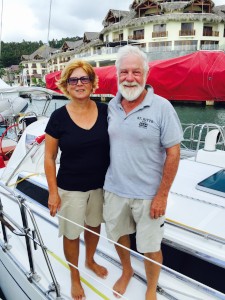
Who: Dutch & Elaine Dresser
Port: Bethel, Maine